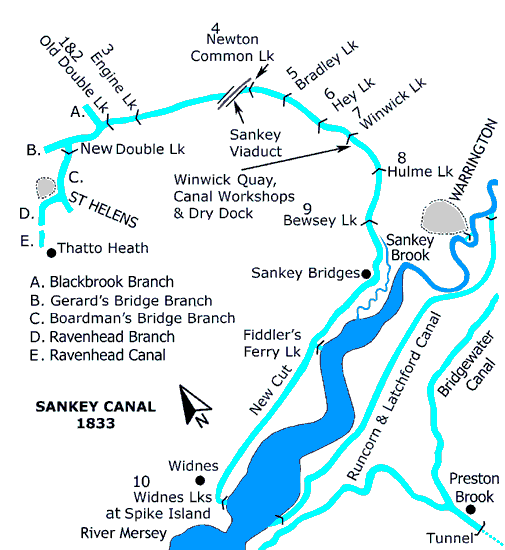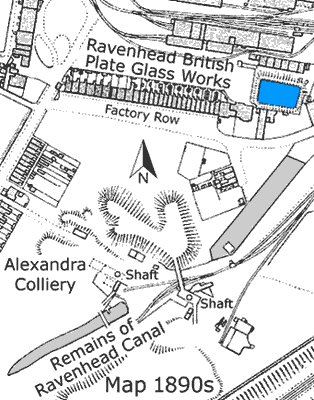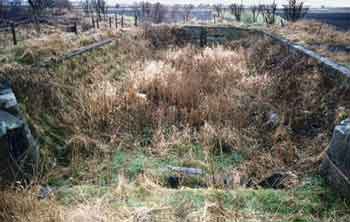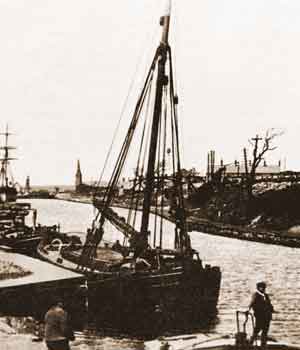
The Sankey Canal lies in the County of Lancashire and the Act of Parliament that sanctioned its construction received the Royal Assent in 1755. This was the Sankey Brook Navigation Act, 28 Geo II cap 8. Its purpose was principally to carry coal for use in the growing chemical industry that was springing up in the Mersey Basin. It opened in 1757 and the coal it was transporting made it the first canal to be constructed in England at the outset of the Industrial Revolution. Its opening accelerated expansion of the chemical industry and this developed along the line of the canal from Widnes, through Newton-le-Willows and Earlestown and then on to St Helens. Up to the time that the canal opened these towns were just small villages.
In time, the Sankey Canal generally became known as the St Helens Canal and in c.1851 the canal company merged with the St Helens Railway Company, to form the St Helens Canal & Railway Company. Subsequently, it was owned by the London & North Western Railway, which became an integral part of the London, Midland & Scottish Railway at the time of the railway grouping on the 1 Jan 1923.
The mainline of the canal began at Blackbrook, close to St Helens, and it proceeded by Earlestown, Winwick, Sankey Bridges and Fiddler's Ferry, where there was an entrance to the river Mersey. Later, it was extended alongside the northern bank of the river Mersey to Widnes, where it terminated at a second entrance to the river Mersey at a place known as Spike Island.
The canal had three short branches around St Helens (marked A,B & C in the following list and on the map). Boardman's Bridge Branch (C) had one branch, the Ravenhead Branch (D).

Ravenhead Canal (E)
This lock-free, isolated canal was about 0.68-miles long and it was located to the south of the terminus of the Ravenhead Branch of the St Helens Canal.
It started at Nutgrove Colliery to the south of Elephant Ln, Thatto Heath. From there, it ran northwards to the Ravenhead British Plate Glass Works and
its purpose was to carry coal from the colliery to the glass works, which opened in 1773. The canal was abandoned in 1867 when Alexandra Colliery opened across the line of the canal as an alternative, and
closer, coal supplier to the glass works. Moreover, the London & North Western Railway Company cut through the canal when their Huyton & St Helens Line opened in 1868.

The Ravenhead Canal and the Ravenhead Branch of the St Helens Canal both took their name from the Ravenhead district of St Helens. The Ravenhead British Plate Glass Works, Ravenhead Glass Bottle Works, Ravenhead Colliery and Ravenhead Copper Works were all situated in this area. The glass industries in this area eventually consolidated as Pilkington Brothers, later Pilkington Ltd.
The World of Glass now lies on the north side of the Ravenhead Branch of the St Helens Canal.

Winwick Quay Dry Dock south east of Winwick Lock (7).
Closure and abandonment of the Sankey Canal
During its decline, the Sankey Canal remined mostly in water right into the centre of St Helens, although the end section of the Ravenhead Branch was lost in 1898 when Canal Street was built across it.
From 1900 traffic on the upper section of the canal decreased and by the 1931 the canal beyond Newton Common Lock (4) had closed to navigation and soon afterwards fixed bridges replaced the swing bridges.
Although the canal closed in stages during the 20th century, raw sugar was still being carried to the works of the Sankey Sugar Company situated above Bradley Lock (3) at Earlestown until 1959.
After that trade ceased the canal was officially abandoned in 1963.
Statistics of the Sankey Canal
The type of boat using the Sankey Canal and its branches was the Mersey Flat and there was a towpath throughout.
| Mainline | |
|---|---|
| 1 & 2 | Old Double Lock (staircase) |
| 3 | Engine |
| 4 | Newton Common |
| 5 | Bradley |
| 6 | Hey |
| 7 | Winwick |
| 8 | Hulme |
| 9 | Bewsey |
| 10 | Widnes (two locks side-by-side), fall to river Mersey |
| - | Fiddler's Ferry, fall to river Mersey |
| - | New Double Lock (staircase), rise from junction of Boardman's Bridge Branch with Gerard's Bridge Branch at Parr |
| Mainline | Miles | Furlongs |
|---|---|---|
| Head of Old Double Lock (1&2), Blackbrook, and junctions with Blackbrook Branch and Gerard's Bridge Branch to: | ||
| Engine Lock (3) | 0 | 5 |
| Newton Common Lock (4), Earlestown (Sankey Railway Viaduct nearby) | 2 | 2 |
| Bradley Lock (5) | 2 | 6 |
| Hey Lock (6) | 3 | 4 |
| Winwick Lock (7) | 5 | 0 |
| Winwick Quay and Canal Workshops | 5 | 1 |
| Hulme Lock (8) | 5 | 3 |
| Bewsey Lock (9) | 6 | 5 |
| Cheshire Lines Committee Railway Viaduct | 7 | 0 |
| Sankey Bridges, one mile away from Warrington | 8 | 1 |
| Fiddler's Ferry Lock, junction with river Mersey | 9 | 6 |
| Widnes Locks (10) (side-by-side), junction with river Mersey | 13 | 1 |
| Gerard's Bridge Branch | ||
| Junction with mainline at head of Old Double Lock (1&2) to: | ||
| Junction with Boardman's Bridge Branch | 1 | 1 |
| Terminus of the branch, near Gerard's Bridge, on the northern side of St Helens | 1 | 3½ |
| Blackbrook Branch | ||
| Junction with mainline at the head of Old Double Lock (1&2) to its terminus | 0 | 5 |
| Boardman's Bridge Branch | ||
| Junction with Gerard's Bridge Branch below New Double Lock at Parr to: | ||
| Terminus of the branch on the southern side of St Helens | 1 | 5 |
| Ravenhead Branch | ||
| To St Helens Crown Glass Works and Ravenhead Copper Works | ||
| Feet | Inches | |
|---|---|---|
| Length through Widnes Locks only | 75 | 0 |
| Width through Widnes Locks only | 20 | 0 |
| Length through all other locks | 68 | 0 |
| Width through all other locks | 16 | 9 |
| Draught | 6 | 3 |
| Headroom | 11 | 0 |
The Sankey Canal was designed so that Mersey Flats could use it because these were the type of sailing boat then in use along the rivers Mersey, Irwell and Weaver, as well as along the coats of Lancashire and North Wales. As some of these boats were fitted with masts, roads that crossed the canal had to cross on swing bridges. Following the dawn of the railway era, with the opening of the Liverpool and Manchester Railway in Sep 1830, railways were also required to cross it on moveable bridges but an exception to this was George Stephenson's magnificent Sankey Viaduct at Earlestown, which crossed high above the canal.
Typically, a Mersey Flat had a length of between 68 feet and 72 feet 6 inches with a beam of between 14 feet 3 inches and 15 feet 9 inches and they could carry up to about 80 tons of cargo. These dimensions also gave some of them access to the Mersey & Irwell Navigation, the Bridgewater Canal and the northern section of the Shropshire Union Canal. It is understood that only two Mersey Flats have survived, Mossdale and Oakdale.

A Mersey Flat moored on the Runcorn and Weston Canal.
This canal was cut parallel to the river Mersey through the outskirts of Runcorn and it was about 1½-miles long. At its southern end it joined the Weaver Navigation and at its northern end it joined the Bridgewater Canal.
The first staircase locks to be built in England were the double locks at St Helens, which came to be known as the Old Double Lock (1&2). Later on, another arrangement of double staircase locks was built on the Boardman's Bridge Branch at its junction with Gerard's Bridge Branch at Parr and these came to be known as the New Double Lock. Staircase locks are so arranged that the top gate of each lock, except the top lock, also form the bottom gate of the lock above.
Following its opening for trade, the Sankey Canal was an immediate commercial success and its opening was soon followed by that of the nearby Bridgewater Canal on the 17 Jul 1761. The opening of the Bridgewater Canal ushered in the era of Canal Mania, which was at its widest extent between 1789 and 1796. Subsequently, canal links for the Sankey Canal were considered but they came to nothing. These were:
A link to the Leeds and Liverpool Canal at Leigh. A link to the Bridgewater Canal and to the Trent and Mersey Canal by means of an aqueduct over the river Mersey at Runcorn.
To begin with, two short extensions of the canal were cut. In 1762, the canal was extended from Sankey Bridges to Fiddler's Ferry, to improve locking down to the river Mersey, and in 1775 it was extended into St Helens. The final extension, known as the 'New Cut', was the longest and this occurred in 1832 when it was extended alongside the northern bank of the Mersey to Spike Island, Widnes, where two locks were built, side-by-side. These were larger than the other locks on the canal. The construction of this extension was brought about in an attempt to counter competition from railways. A small dock, Widnes Dock, was also built immediately to the east of the two locks and this was provided with a separate lock.
Left, Widnes Locks, & right, Fiddler's Ferry Lock*.
Scheduled Monuments
| Name | Location | Grade | List Entry |
|---|---|---|---|
| New Double Lock | Lock St, St Helens | II | 1283484 |
| Sankey Viaduct over Sankey Brook | Pickering Drive, Earlestown, Newton-le-Willows | I | 1075927 |
| Bradley Lock (5) | Bradlegh Rd, Earlestown, Newton-le-Willows | II | 1075926 |
Top: Sankey Viaduct carrying the Liverpool and Manchester Railway over the Sankey Canal.
Bottom left: New Double Lock at the entrance to the Boardman's Bridge Branch.
Bottom right: Bradley Lock (5).